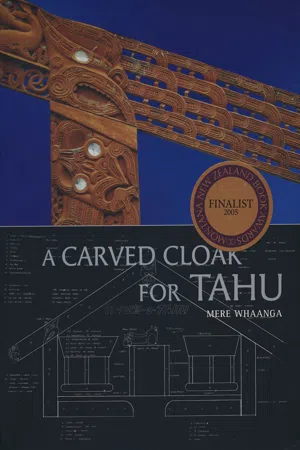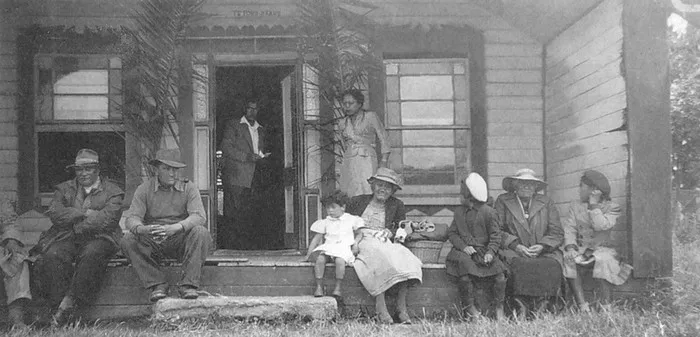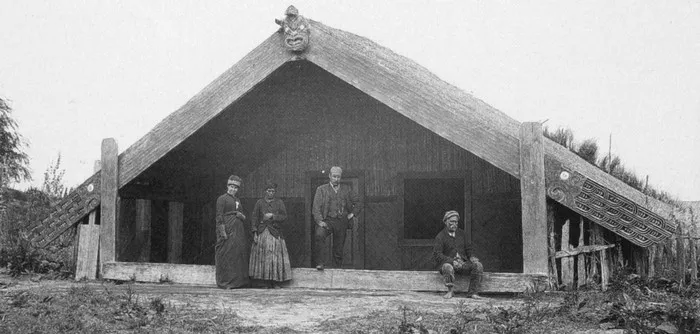
- 280 pages
- English
- ePUB (mobile friendly)
- Available on iOS & Android
eBook - ePub
About this book
Oral histories, legends, and accounts of contemporary life of a New Zealand Maori tribe are presented in this cultural that includes colonial histories of the Native Land Court and traditional histories from the Northern Hawke's Bay.
Frequently asked questions
Yes, you can cancel anytime from the Subscription tab in your account settings on the Perlego website. Your subscription will stay active until the end of your current billing period. Learn how to cancel your subscription.
At the moment all of our mobile-responsive ePub books are available to download via the app. Most of our PDFs are also available to download and we're working on making the final remaining ones downloadable now. Learn more here.
Perlego offers two plans: Essential and Complete
- Essential is ideal for learners and professionals who enjoy exploring a wide range of subjects. Access the Essential Library with 800,000+ trusted titles and best-sellers across business, personal growth, and the humanities. Includes unlimited reading time and Standard Read Aloud voice.
- Complete: Perfect for advanced learners and researchers needing full, unrestricted access. Unlock 1.4M+ books across hundreds of subjects, including academic and specialized titles. The Complete Plan also includes advanced features like Premium Read Aloud and Research Assistant.
We are an online textbook subscription service, where you can get access to an entire online library for less than the price of a single book per month. With over 1 million books across 1000+ topics, we’ve got you covered! Learn more here.
Look out for the read-aloud symbol on your next book to see if you can listen to it. The read-aloud tool reads text aloud for you, highlighting the text as it is being read. You can pause it, speed it up and slow it down. Learn more here.
Yes! You can use the Perlego app on both iOS or Android devices to read anytime, anywhere — even offline. Perfect for commutes or when you’re on the go.
Please note we cannot support devices running on iOS 13 and Android 7 or earlier. Learn more about using the app.
Please note we cannot support devices running on iOS 13 and Android 7 or earlier. Learn more about using the app.
Yes, you can access A Carved Cloak for Tahu by Mere Whaanga in PDF and/or ePUB format, as well as other popular books in History & Asian History. We have over one million books available in our catalogue for you to explore.
Information
Mana Whakapapa
CHAPTER ONE
Ko Te Poho O Tahu Te Wharenui
Te Poho O Tahu – the bosom of Tahu – is the place where we gather, the most appropriate place to discuss all that is important to us, the descendants of Tahu Potiki.
There are many wharenui in the rohe of Ngāti Kahungunu ki Wairoa, and most of us have connections to more than one of them. We are used to having all our hui at a marae, where we can discuss matters of importance within our whare tipuna, surrounded by our ancestors and confident that the outcome will be influenced by them.
I must admit that I took this richness and stability of identity very much for granted. But then, while working at the Auckland War Memorial Museum, I came to know Māori who had had little contact with an ancestral house. For some this was because they had spent most of their lives in areas far from their traditional tribal lands and marae, for others it was because their wharenui had been removed from its marae and placed in a museum. I had never before considered what it must be like to be Māori and not have a marae, not have a meeting house.
Many Visitors Attend Opening of Meeting House
Over 1500 visitors attended at Iwitea on Saturday for the opening of the new meeting house by Sir Eruera Tirikatene, M.P. for Southern Maori. Many hundreds more attended from around the district to add to the importance of the occasion. The official opening function was followed by a discussion on problems affecting the Maori people and a social and dance was held in the evening. (Wairoa Star, 8 April 1963)

Te Poho O Tahu, 1956. Seated adults, left to right: Jock Paku, Te Hore Epanaia Whaanga, Te Arau Edwards, unknown, T.N. WHAANGA
Although I grew up some distance from our marae, we went to Iwitea on many occasions. For instance, in 19561 was one of the flower girls at the wedding of one of my father’s sisters. There are photos of my aunt and uncle, and photos of the whole wedding party, but the one that is clearest in my mind shows my father – with his pipe and wearing a hat tilted just so – sitting with my mother’s aunt on the veranda. The wharenui was the old Tahu, and my aunt’s wedding was the last function held there. That wharenui was demolished soon after and the existing Te Poho O Tahu built. The current Te Poho O Tahu was formally opened on 6 April 1963. It is the fourth Tahu; the first two were raupo whare.
Most of our meetings about land are held on our marae. For instance, it is only right that the annual general meeting of the Whakaki 2N Māori Incorporation is held in Te Poho O Tahu, because this incorporation is the landholding organisation of the hapū associated with Iwitea marae, which is situated on one of the modern-day boundaries of this land. The hapū are also significant shareholders in two other Māori landholding bodies – Te Whakaari Incorporation and Anewa Trust – which often have their annual general meetings in Te Poho O Tahu. Church services are held here too – although now less frequently than in the past, when regular Ringatu, Anglican and Ratana services took place in the wharenui.
The wharenui is the most appropriate place to hold wānanga. What other house is a more appropriate setting in which to learn about whakapapa, tribal affiliations, waiata, history, the land, tikanga, kawa? The book The Seven Whales: He Pakiwaitara a Ngai Tahu Matawhaiti was launched on the marae, from which six of the seven whales, our maunga tapu, can be seen. Contemporary issues of concern to the people are also discussed here. In recent times there have been numerous meetings and discussions regarding a proposal by Westech to drill for gas on the Whakaki 2N block. This was a very contentious issue that had the potential to be deeply divisive, but within the poho of our ancestor Tahu a strategy to obtain a unified voice of the people was developed and the issues resolved.

Te Poho O Tahu, 1889. Horomona Turoa is seated, E. R. WILLIAMS COLLECTION, ALEXANDER TURNBULL LIBRARY, G 25569–1/1
And of course the wharenui is where our tūpāpaku lie. We who have descended from this ancestor, and those who have come to be members of our hapū, are brought back to the embrace of Tahu Potiki for the tangihanga, to be farewelled before being returned to the mother of all, Papatuanuku. The wharenui, then, serves as a gathering place in times of joy and celebration, times of stress and sadness. It serves as a church, a hall of council and, truly, a meeting house.
The symbolism of the meeting house and the marae
The wharenui represents the ancestor of the tribal group for whom...
Table of contents
- Cover
- Half-title
- Title Page
- Table of Contents
- Introduction
- Mana Whakapapa
- Mana Whenua
- Mana Tangata
- Notes
- Bibliography
- Index
- Copyright